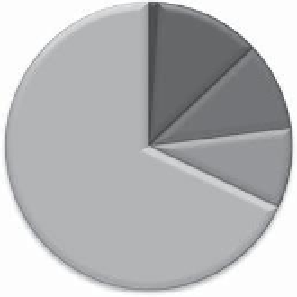Agriculture Reference
In-Depth Information
Food assistance programmes in the USA are
funded through the Farm Bill, a major piece of
federal legislation that is renewed every 5 years.
The Farm Bill covers multiple programmes
through the US Department of Agriculture
(USDA) including funding for farm and ranch
subsidy programmes, farm and ranch insurance
programmes and conservation initiatives.
However, the majority of the Farm Bill goes to
support 15 different food access and nutrition
improvement programmes (Fig. 13.2). In the
2008 Farm Bill, 68% of funding was allocated
to nutrition programmes including the National
School Lunch Program, SNAP and WIC (Young
et al
., 2008). These programmes provide SNAP
and WIC recipients with access to fresh fruits
and vegetables, dairy and cheeses, eggs, beans
and groundnut butter. As well, the National
School Lunch Program provides daily meals
for more than 31 million American children
(USDA ERS, 2011a).
More recent efforts have also been made in
these programmes to incorporate aspects of
environmental and economic sustainability.
WIC and SNAP benefits can now be used at
farmers' markets and farm stands throughout
the country (Box 13.1). As well, the National
School Lunch Program has initiated a variety of
programmes to encourage local provision of
agricultural products including grass-fed beef in
some regions to help support local farmers and
ranchers and reduce the distance food travels
(Ulla, 2010). While the intent of government
Food access and food security
(Farm Bill breakdown)
One of the key components of social sustaina-
bility in agriculture is the production of food
and fibre. Farmers and ranchers provide signifi-
cantly greater amounts of food today than in
previous years, largely as a result of mechaniza-
tion, traditional plant and animal breeding, and
agricultural inputs such as manures and ferti-
lizers. According to the United Nations Food
and Agriculture Organization, there is enough
food available in the world for each individual
to consume nearly 2800 calories a day (UN
FAO, 2007) - notably above the US Food and
Drug Administration recommended daily 2000
calories a day (USFDA, 2004). Yet, despite con-
tinued agricultural growth and productivity,
food security remains a significant problem
globally. In 2010, it is estimated that there were
925 million undernourished people in the world
(UN FAO, 2010). These statistics demonstrate
that simply producing food is not enough to
guarantee that people have access to adequate
nutrition and the ability to acquire food directly.
As a result, our world currently suffers from a
food access problem, largely social and eco-
nomic in nature, rather than an agricultural
food production issue.
A sustainable food and agriculture system is
one in which food is not only grown but is available
and secure for all people. The 1996 World Food
Summit defined food security as existing 'when all
people at all times have access to sufficient, safe,
nutritious food to maintain a healthy and active
life.' Similar to sustainability, food security is based
on three pillars including food availability, food
access and food use (WHO, 2012). In the USA, an
estimated 14.5% (17.2 million) of households
were food insecure in 2010. Of these, 3.9 million
households with children were food insecure
(Coleman-Jensen
et al
., 2011). These food insecuri-
ties in the USA are combated through a number of
government programmes. In 2011, 46.2 million
people (about one in seven Americans) partici-
pated in the government sponsored Supplemental
Nutrition Assistance Program (SNAP) (USDA FNS,
2011a) with more than 9 million receiving assis-
tance from the Women, Infants and Children
(WIC) Program designed for pregnant and nurs-
ing women and children under the age of 5 (USDA
FNS, 2011b).
Other
1%
Commodities
12%
Crop
insurance
10%
Nutrition
68%
Conservation
9%
Fig. 13.2.
Allocation of resources to programmes
supported by the 2008 Farm Bill. Source: USDA
Economic Research Service using Congressional
Budget Office estimates.


